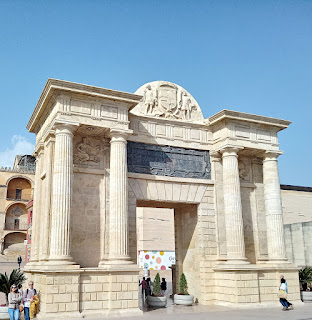We had two full days in Córdoba!
When you investigate sites, you invariably see this classic view of the interior of the Mezquita-Catedral, the Mosque-cathedral.
Day 1 - we went to see the ancient synagogue, then to the Mezquita-Catedral (the mosque-cathedral), finishing with a late lunch at Casa Pepe's. After a little shopping and relaxing at our apartment, we went to the Hotel Hesperia for the evening view!
The synagogue open for visiting was just one small room; to me, its history (see here) is the interesting part.
 |
| Ancient Synagogue |
The Mezquita-Catedral began as a mosque in 785 AD. It was converted to a cathedral in 1236. Its Renaissance nave and transept was added in the 16th century.
Inside, we were nearly overwhelmed by all the many arches, paintings, and carvings
Day 2: we toured the Alcázar de los Reyes Cristianos - the Fortress Palace of the Christian Kings. It's main attractions are the mosaics, gardens, and the tower (which we didn't climb). It dates from Roman times, and the mix of architecture shows its history - Roman, Visigoth, Moors, and the Spanish reconquest.
It turns out that an Alcazaba is a fortress where troops were housed. An Alcázar is a fortress that also housed Someone Of Importance, like a king. Sevilla and Córdoba both have Alcázars (notice the accent...), but Málaga has an Alcazaba.
 |
| One of the mosaics |
There are 55,000 square meters of garden, in the Arab style - palm, cypress, and orange trees, ponds, and fountains abound.
~~~
There are more photos in my Córdoba 2023 album.
Here is more information on the mosque-cathedral.
You can read more about the Alcázar here and here.





























No comments:
Post a Comment